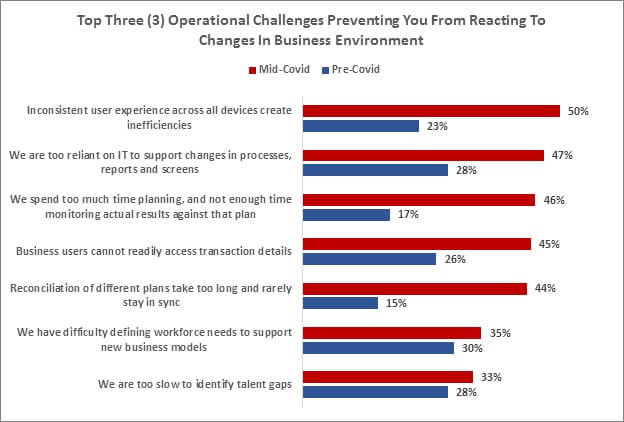A Remote Workforce Creates Unique Operational Challenges For Retailers
Back about a thousand years ago – in February 2020 – RSR was commissioned to perform benchmark research that included several questions on managing the workforce, including planning and budgeting. Recently, we were commissioned by Ceridian to do a complete study on workforce management as it is today.
Steve and I are still working through the data, but one question, in particular, allows us to compare operational challenges then (before) and now, (in the middle of the COVID-19 pandemic). It really jumped out at me. The question is a staple of RSR’s benchmarks, “What are the top three operational challenges you face…” in this case, “…preventing you from reacting to changes in the business environment?”
What the data in the figure below tells us a straightforward story. When the workforce becomes disbursed and is working from remote locations, seemingly minor issues take on major significance.

Inefficiencies matter when you’re at home working from your Mac, for example, rather than the PC in your office. There may be no one to ask how the application actually works in your in-home browser, or even how to install a VPN on your new computer.
Along the same line, using IT to support changes in processes, reports and screens can be frustrating enough in a centralized work environment. What’s a business user to do if she needs a change and she’s a hundred miles away from her IT group? As we can see from the figure above, it has become a very, large issue.
It seems one theme runs through all these responses: retailers scarcely paid attention to what were minor inconveniences when they could just make a phone call or shout across the room at a co-worker. Now, in an environment where anyone can be anywhere, it matters. A LOT. And simply gathering an IT steering committee together to try to solve the problem can be challenging.
It’s not like people are down the hall or even down the block. They can literally be hundreds of miles away.
Consider this: the hot, muggy, unpleasant Miami summer is slowly winding down, but I became frustrated enough in August that I started looking for a house a couple of hours north of New York for a summer/fall getaway. I went to college up there, and frankly love it. I just really don’t love winter.
I had done some preliminary investigations a couple of years ago, and unless you wanted to live right on a lake, it was quite affordable. Well, in September, I found a place I really liked, right near Ashokan Reservoir and Woodstock. For me, this is as close to autumn heaven as it gets. A small manageable house, 1,000 square feet, advertised with a high-speed internet connection, and completely re-done. On two acres. Sounded great until I looked at the price tag. $300,000. The kicker? The house was bought for $240,000 three months ago. So it was a flip. Nor harm there. Everyone is entitled to make a buck. But I simply couldn’t relate to buying such a small house, without even a garage for that much money. Heck, it’s more than I owe on my house in Miami, which is almost three times the size. Two of the main selling points of this house was “completely re-done” and “high speed internet.” And that’s where I can get back to my story.
Someone is going to buy that house. In all likelihood, that person will have a job in New York City and has no interest in spending the winter in the city, which rapidly becomes a Petri dish. He or she will head up to the country house, bring her computer or (worse) buy a new one, and log in to the home office system.
Suddenly all the operational challenges cited above become very, very real. It’s hard to work fast, and almost impossible to get hold of IT, what to speak of have them make changes for you. Getting access to data can be challenging, especially transaction details.
What’s the takeaway? Whether the COVID crisis ends in mid-2021 or early-to-mid 2022, we’ve got a ways to go, and once people realize they can work from more desirable locations with lower costs of living, it’s not going to be easy to get them back to the office.
Retailers have some serious re-adjustments to make. The in-store workforce is now more important, distribution centers are proliferating like bunnies, and the home office workforce is wherever it wants to be.
All decision-making must be done either through Zoom meetings, or later, when people can agree to come into the office for a meeting once a week or so.
The watchwords here are agility, simplicity and empowerment. The organization must become more agile, application usage must become simpler, and line workers must become more empowered with data and decision-making authority. Ask yourself. Can you do this? If not, process and IT changes MUST become part of the fabric of your business. Not tomorrow, today. And it certainly can’t take eighteen months to get it all done. That’s not agile, nor is it adequate.
The world has changed. We are mid-pandemic, but full bore into transformation. And the transformation will likely outlast the pandemic. There’s a lot to do, even as we put our customer-bases back together again and figure out what people really want to buy besides houses in the country!
Stay tuned for more data about the state of workforce management today.
